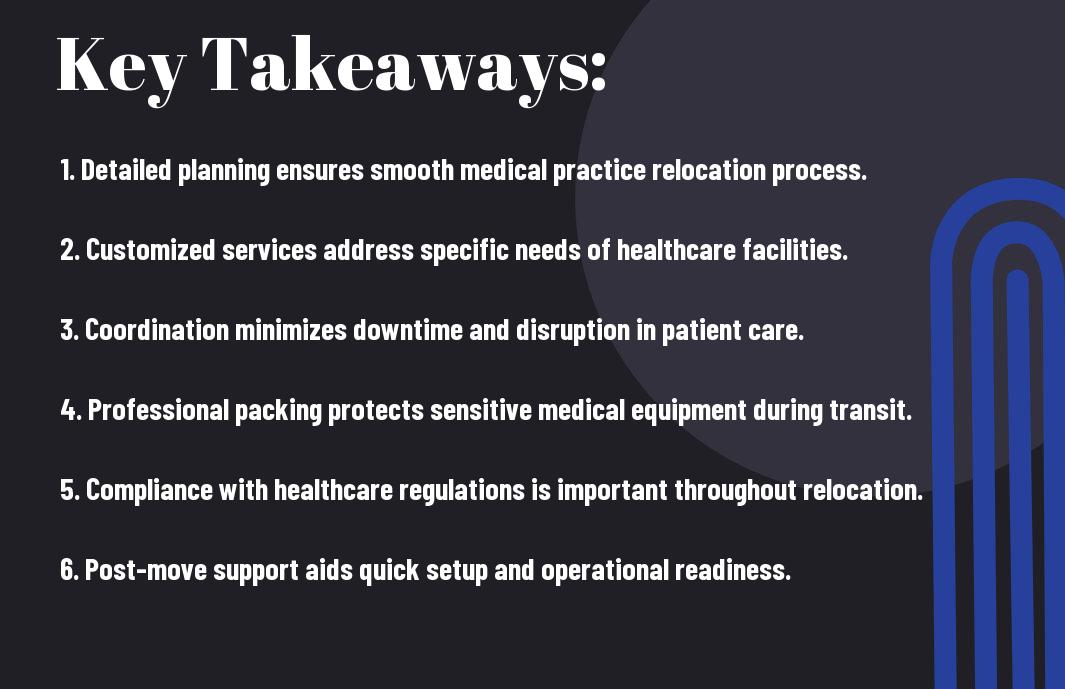Planning a medical practice relocation is an intricate process that requires careful consideration and execution to minimize disruption to your services. Whether you’re expanding, downsizing, or seeking a more suitable location, understanding the complexities involved can help you make informed decisions. This comprehensive guide will walk you through the key aspects of medical practice relocation services, from initial planning and logistical considerations to the final execution, ensuring that your transition is as smooth and efficient as possible.

The Strategic Blueprint: Crafting a Relocation Plan
A well-structured relocation plan serves as the backbone of your successful medical practice move. This blueprint outlines all logistical elements, timelines, and responsibilities, ensuring that every detail is accounted for. By identifying key milestones and assigning appropriate personnel, you create a clear pathway from your current location to the new facility. This strategic approach not only minimizes disruptions to patient care but also maximizes the chances of a seamless transition.
Assessing Current Practice Location and Needs
Evaluating your current practice location is the first step to understanding your unique needs. This involves analyzing the physical space, patient flow, and accessibility, as well as identifying any shortcomings that may have affected your service delivery. Considerations such as parking availability, local competition, and proximity to referral sources will greatly influence your decision-making process.
Defining Future Goals and Patient Demographics
Establishing your future goals is pivotal in crafting an effective relocation plan. Assess your patient demographics, considering age, socioeconomic status, and healthcare needs, to tailor the new location perfectly to your target audience. Aim to align your facility’s features and services with the evolving demands of your patient base, which could include expanding telehealth capabilities or accommodating specialized treatments.
In-depth analysis of your existing patient demographics alongside future goals will help shape the services you provide and the design of the new space. For instance, if you notice a rising trend in pediatric patients, incorporating child-friendly waiting areas or engaging play zones can enhance their experience. On the other hand, if your goal is to attract more geriatric patients, ensuring ease of access and appropriate healthcare facilities, such as walk-in clinics, could become a focal point in your strategy. Balancing these objectives will create a facility that not only meets your operational needs but also fosters patient loyalty and population growth.
The Logistics Labyrinth: Navigating Practical Relocation Challenges
Relocating your medical practice involves navigating a series of logistical hurdles that can seem overwhelming. From managing the physical move of equipment to aligning schedules so patient care remains seamless, the intricacies of relocation require meticulous planning. Each aspect, from packing medical instruments to coordinating with moving companies, needs careful attention to ensure no detail is overlooked, allowing you to focus on what truly matters – your patients.
Real Estate Considerations: Selecting the Ideal Space
Your choice of location can significantly impact your practice’s accessibility and growth. Look for spaces that resonate with your patient demographics, ensuring proximity to public transport and other amenities. Consider factors like square footage, configuration for medical use, and potential for future expansion. A well-suited environment enhances patient experience and can lead to increased volume over time.
Compliance and Regulatory Requirements for New Locations
Upon selecting your new location, a thorough understanding of compliance and regulatory requirements becomes necessary. This includes making sure the facility meets local zoning laws, state licensing regulations, and healthcare-specific safety standards. Additionally, policies on insurance, waste disposal, and patient privacy protections must be revisited to align with your new operational framework.
Ensuring compliance with various regulations when moving your practice safeguards both your operations and your patients. You’ll need to verify that all licenses are transferred or obtained for the new location, covering everything from medical waste management to healthcare signage. Understanding local healthcare regulations and undergoing necessary inspections are paramount; failure to comply can not only delay your opening but also pose serious legal risks. Additionally, building relationships with local health departments early in the process can pave the way for a smoother transition, reducing headaches down the line.
The Team Dynamics: Building Your Relocation Task Force
Successful medical practice relocation hinges on assembling a dedicated task force that combines various skills and expertise. This team should represent different facets of your practice, from administrative staff to medical professionals, ensuring a comprehensive approach to the relocation process. Collaboration is the backbone of this team, enabling effective problem-solving and innovative solutions to emerge throughout the transition.
Roles and Responsibilities: Who Does What?
Each member of your relocation task force plays a pivotal role in ensuring a seamless move. Ideally, appoint a team leader to oversee the process, while other key roles include logistics coordinator, communication officer, and IT specialist. The logistics coordinator manages scheduling and resource allocation, while the communication officer ensures everyone is informed. IT specialists focus on maintaining the integrity of systems during the transition.
Effective Communication Strategies During the Move
Clear communication strategies are imperative throughout your medical practice relocation. Keeping all team members informed fosters transparency and encourages teamwork. Regular meetings, status updates, and a centralized communication platform can significantly enhance collaboration, allowing for immediate feedback and quick adjustments to the plan.
For optimal communication, establish a consistent schedule for team meetings, ensuring everyone understands their roles and the progress of the move. Utilize shared digital tools, such as project management software or group messaging apps, to create a centralized hub for information exchange. Encourage open dialogue by creating an environment where team members feel comfortable voicing concerns or suggesting improvements. This proactive approach not only keeps everyone aligned but also minimizes potential disruptions during the relocation process.
Molding the Patient Experience: Ensuring Continuity of Care
Every step of your practice relocation must consider the patient experience to ensure continuity of care. Transitioning to a new location may create apprehension among patients, and maintaining their trust is vital. By planning strategically, you can foster a sense of stability and seamless care during this transition. Effective communication and engagement strategies implemented pre- and post-move can keep your patients informed and comfortable, minimizing disruption and enhancing their experience in your new facility.
Pre-Move Patient Communication and Education
Informing your patients about the relocation well in advance plays a pivotal role in their overall experience. Share the relocation timeline, new address, and details on how patient care will remain uninterrupted. Utilize various communication channels, such as emails, newsletters, or social media updates, to ensure that everyone stays informed. Providing educational materials about the new facility’s improvements can also create excitement and reassurance among your patients.
Post-Move Engagement: Welcoming Patients to Their New Home
Welcoming patients to your new office space requires more than just a polite greeting; it involves creating an atmosphere of warmth and familiarity. Host an open house event to invite patients and their families to explore the new space, meet the staff, and even participate in guided tours. Implementing a feedback system can help gauge their experiences and adapt services as necessary. By making patients feel valued and involved, you can effectively strengthen their loyalty and trust in your practice.
Your open house can feature light refreshments, giveaways, and activities for children, providing an enjoyable experience that resonates with patients. Personal touches, such as introducing staff by name and sharing stories of care, help bridge the emotional gap that a relocation may create. Take the time to highlight new equipment or services that will enhance patient care moving forward. Encourage patients to share their thoughts and feedback throughout their visit; this not only makes them feel heard but allows you to adjust your approach based on their needs and suggestions, fostering long-term commitment to your practice post-move.

Tech Transition: Integrating Systems for Seamless Operations
Efficient operation after relocation hinges on a proper tech transition. Integrating your existing systems with new infrastructure minimizes downtime and enhances patient care. This can include everything from electronic health records (EHR) to appointment scheduling software. Engaging qualified IT experts ensures that each system communicates effectively, streamlining operations and enhancing overall productivity.
Infrastructure Planning: IT and Equipment Needs
Your new location comes with distinct IT and equipment needs that must align with practice operations. Assess potential upgrades or replacements for outdated technology that may hinder workflow. Planning for high-speed internet, server requirements, workstations, and medical equipment configurations determines how well your practice will function in the new space.
Data Migration and Security Measures
Implementing robust data migration processes safeguards patient information during your move. Ensuring that all data is accurately transferred to the new systems—and protected against breaches—provides peace of mind. Employing encryption and secure transfer protocols becomes pivotal in maintaining confidentiality and compliance with regulations such as HIPAA.
Data migration involves more than just transferring files; it requires meticulous verification processes. Establish protocols to ensure data integrity, backing up information before migration. Consider conducting thorough testing to confirm compatibility with new systems. Additionally, integrating advanced security measures—including firewalls, access controls, and regular audits—further protects sensitive information. By prioritizing these elements, you maintain a trustful environment for your patients, vital for the successful operation of your newly relocated practice.
To wrap up
To wrap up, understanding the complexities of medical practice relocation services is crucial for ensuring a seamless transition for you and your staff. By engaging a dedicated team to assist with planning, logistics, and execution, you can focus on continuing quality patient care without the stress of managing the move on your own. This comprehensive approach not only mitigates risks but also enhances the overall efficiency of your relocation, allowing you to start fresh in your new location with minimal disruptions to your practice.




